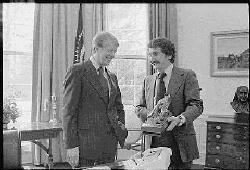

Page 2
1.1: Trouble in the Center
Iran had been a hotspot since the beginning of the year when the Shah has been overthrown and replaced with a crazy, dictatorial, Islamic regime. In November things got markedly worse. Iranian militants seized the US Embassy in Tehran and took the 66 personal hostages. This was the last thing President Carter needed. As far as the 'man on the street' in America was concerned, this was an outrage and demanded firm action. Carter deployed the US Navy into the Persian Gulf and demanded the release of the hostages; the Iranians released 13, and in exchange for the remainder demanded a number of American concessions. The United States refused to negotiate for hostages. Carter, a near-pacifist in many ways, was very reluctant to take action. However, in case he did decide to do so a number of options were prepared, ranging from an all-out air campaign against Iran to a simple raid to free the hostages with everything in between. As the middle of December approached and Carter's humiliation was shown for the entire world to see the CIA reported alarming signs coming from other sources.
Fig. 2. President Jimmy Carter1.2: The Polish CoupAt that time preliminary action orders had been issued to many US units in the region with a wing of B-52D Stratofortress Bombers deploying to Diego Garcia in the Indian Ocean. A US Carrier Battle Group, spearheaded by the USS Nimitz also arrived in the region.
The strikes continued and expanded through all of November and into December, paralyzing the Polish National economy. The Polish Government was unwilling to put down the strikes with military force, as the loyalty of many was somewhat uncertain. They repeatedly requested Soviet intervention, which the Soviets declined, believing that it would look better internationally if the Polish handled it. Negotiations began early in November with the Polish government proving willing to offer much including modest wage increases and a reduction in working hours. They were, however, not willing to compromise the security of the Polish Government.
The delaying tactics of the negotiators (now claiming to represent a group called 'Solidarity') soon revealed that the strikers believed themselves to be in a position of power and rather unreasonable, demanding things which were simply beyond the ability of the Polish Government to grant. Early in December civil service employees began to walk off the job in support of the strikes, which were beginning to look a lot like a revolution. As the demands being made by the striking workers began to demand things like open elections the Soviet Unions pointedly told the Polish government that they were expected to consult their true socialist conscience and take appropriate action. Finally with no other real choice on December 15th, the Polish sent the 5th Motor Rifle Division into Warsaw and the Marine Division into Gdansk. It was believed that by suppressing the centers of the strikes, everything would fall into place. They couldn't have been more wrong.
As the Divisions of the Polish Army began to move into positions in and around the city it became clear who the average grunt was sympathetic towards, already men were defecting in drips and drabs to help defend Solidarity. The Commander of the 5th Motor Rifle and the Commander of the Second Army to which the unit belonged were life-long friends, and though they had many disagreements on many things, there was one thing they both agreed upon. A free Poland, even a ruined one, was better than a Soviet Poland, even a prosperous one. Now they were facing the prospect on a ruined, Soviet Poland. They also were both well aware that if they failed to suppress the strikes (which they believed they would) they would both be ruined themselves. Better to flow with the tide than fight it. As ordered the 5th Motor Rifle entered Warsaw on the morning of the 17th. However, instead of heading to the factories that were on strike they found and arrested the Polish Politburo and the High Command.
It came as a complete surprise, even to the rest of the Polish Armed Forces many of who supported the ad hoc coup. General Sandoski, the 2nd Army Commander went on State Radio (the facilities having been captured with ease) and proclaimed the Republic of Poland with himself as President. All over Poland confused fighting erupted between units of the Polish Army (with in some cases Soviet troops being drawn into the clashes). From his new offices (formerly belonging to the General Secretary) the President began to plot to keep Polish independence, a task which would not be easy. By the early hours of the 18th Sandoski had secured pledges of loyalty from the commanders of all major Polish ground formations and most of the air force (the disloyal portions having flown away). Polish ground units deployed around Gdansk and Warsaw amid cheering crowds of Poles proudly displaying the Polish flag minus the communist insignia. The troops were briefed on fighting positions facing to the east and to the west. They were encircled.
Fig. 2. The New Polish Flag


